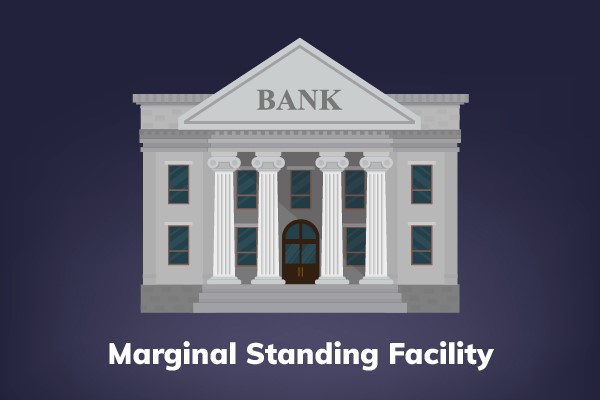A Beginner’s Guide To Marginal Standing Facility

The Reserve Bank of India (RBI) is the central bank that lays down the rules and regulations of operation for all banks in the country. As the regulator and overseeing authority of banking functions, the RBI employs various measures to help banks manage short-term emergencies and long-term capital requirements. One such measure is the Marginal Standing Facility (MSF) which helps banks deal with their liquidity issues.
This article breaks down every detail concerning Marginal Standing Facility. Read on to understand MSF in simple terms.
What is a Marginal Standing Facility (MSF)?
The Marginal Standing Facility is a policy RBI launched in 2011-12, which reformed the existing monetary policies. Under the Marginal Standing Facility, scheduled commercial banks are allowed to borrow from the RBI if the inter-bank liquidity is affected and the bank has no other source for liquid funds. Commercial banks can achieve overnight liquidity through the Marginal Standing Facility and meet their short-term needs.
How does Marginal Standing Facility Work?
If banks run out of liquidity and need instant funds, they can use the Marginal Standing Facility and borrow from the RBI. To borrow, banks pledge the Government securities they own as a part of their Statutory Liquidity Ratio. The RBI, then, offers funds up to 1% of the bank’s NDTL (Net Demand and Time Liabilities).
Why was Marginal Standing Facility Introduced?
The RBI introduced the concept of the Marginal Standing Facility in 2011-12 to help banks absorb liquidity shocks in emergencies. Banks might face a shortage of liquid funds in the case of considerable redemption pressure or in other emergencies. In such situations, the Marginal Standing Facility provides banks with a lifeline. RBI also introduced the Marginal Standing Facility to stabilize banks and reduce the volatility in overnight lending rates (between banks).
What is the Marginal Standing Facility Rate in India?
When banks borrow from the RBI, the RBI charges an interest rate on the funds. This interest rate is called the Marginal Standing Facility rate. The RBI fixed this rate is always higher than the repo rate. Moreover, the RBI also reviews the Marginal Standing Facility rate periodically and can change it if required depending on its monetary policy.
What is the Current Marginal Standing Facility in India?
As of June 2022, the RBI has hiked the MSF rate. The current Marginal Standing Facility rate in India is 5.15%. The policy repo rate, on the other hand, stands at 4.90%.
Terms to Know about Marginal Standing Facility (MSF)
In order to clearly understand the concept of Marginal Standing Facility and how it works, here are a few important terms that you need to know about –
- Statutory Liquidity Ratio (SLR)
The Statutory Liquidity Ratio (SLR) is the minimum percentage of deposits that banks must maintain before offering credit to their customers. The SLR acts as a liquid reserve that banks can maintain in the form of gold, cash, or other securities.
SLR is calculated as the ratio of liquid assets to banks’ net demand and time liabilities.
- Net Demand and Time Deposit Liabilities (NDTL)
The Net Demand and Time Liabilities (NDTL) include all the types of deposits banks offer their customers. Demand liabilities are those which customers can withdraw at any time, on-demand like a current account. On the other hand, time liabilities are those withdrawn after a specified time, like fixed or recurring deposits.
- Repo Rate
Repo, short for ‘repurchase’ is the rate of interest at which banks borrow short-term loans from the RBI. Under the repo option, banks sell their bonds and securities to the RBI on a short-term basis and get funds against such sales. The sale is based on an agreement that banks would repurchase the sold securities at a later date and at a predefined rate.
- Reverse Repo Rate
As the name suggests, reverse repo is the opposite of repo. Under reverse repo, the RBI borrows money from banks. Banks with surplus funds loan them to the RBI and earn interest on the same.
- Bank Rate
Banks can also avail of long-term loans from the RBI. Such loans are issued at an interest rate called the bank rate.
Differences between Marginal Standing Facility, Repo Rate and Bank Rate
While Marginal Standing Facility, repo rate, and bank rate all involve borrowing from the RBI, these terms are quite different. Here’s a look at the differences between these three terms.
| Basis of difference | Marginal Standing Facility | Repo rate | Bank rate |
| Meaning | The Marginal Standing Facility is a feature through which banks can borrow overnight funds from the RBI by pledging Government securities that they own | Repo is the process in which banks borrow from the RBI by selling their securities and on an agreement to buy back such securities later on | Bank rate is applicable when banks borrow long-term loans from the RBI |
| Borrowing tenure | Overnight, limited to 24 hours | Short-term in nature | Long-term borrowing |
| Securities pledged | Government securities. Banks can use their SLR securities | Bonds and other securities. SLR securities cannot be used | No security is pledged |
| Rate of interest | Higher than the repo rate. Currently stands at 5.15% as of June 2022 | Lower than the Marginal Standing Facility rate. Currently stands at 4.9% | Depends on RBI’s monetary policy. Currently stands at 5.15% |
| Eligibility | Scheduled commercial banks that have a Subsidiary General Ledger (SGL) and a current account with the RBI | Commercial banks | All types of banks and financial institutions |
How Can Banks Borrow Funds under Marginal Standing Facility?
If banks run out of liquidity and need emergency assistance, they can request the RBI for the Marginal Standing Facility. They would have to pledge the Government securities they hold under their SLR obligation. After that, RBI would transfer the funds to the bank. The minimum borrowing under the Marginal Standing Facility is Rs.1 crore, and the facility is available on all working days excluding Saturdays.
Impact of Marginal Standing Facility Rate in India
While the Marginal Standing Facility rate is applicable for banks, it can also impact you. Here’s how –
- The Marginal Standing Facility rate affects the loan rates charged by banks. If the MSF rate is increased, banks pay more to the RBI for emergency borrowing. They might charge higher rates to their borrowers to meet the high MSF rate.
- The opposite might also hold true. If the MSF rate is slashed, loans might become cheaper (for you)
- The MSF rate also impacts the monetary policy and determines the value of INR against US Dollars
Final Word
The Marginal Standing Facility helps banks meet their emergency and liquidity needs by providing financial stability. The rate at which banks borrow from the RBI, called the Marginal Standing Facility rate, might impact the interest rates at which borrow loans. So, keep a tab on the MSF rates that the RBI revises periodically to understand the changing loan interest rates.
FAQs on Marginal Standing Facility
Ans: No, there is no fixed percentage of the difference between the Marginal Standing Facility rate vs repo rate. The Marginal Standing Facility rate can be fixed in any manner by the RBI. Usually, however, there is a difference of 25 basis points between the MSF rate and the repo rate but this difference is not fixed.
Ans: Yes, they can. Banks can borrow in multiples of Rs. 1 crore whenever they need emergency liquidity funding. Rs. 1 crore is the minimum borrowing under the MSF.
Ans: The Marginal Standing Facility allows banks to dip into their SLR for availing overnight finance. So, when the Marginal Standing Facility is extended, banks don’t have to maintain their SLR. However, once the loan under MSF is repaid, the SLR limit must be maintained.
Ans: No, there is no limit. Banks can resort to MSF any number of times and up to any amount provided they have the required Government securities to pledge.
Ans: The loan under Marginal Standing Facility is allowed for up to 24 hours.
Disclaimer
This article is solely for educational purposes. Navi doesn't take any responsibility for the information or claims made in the blog.

Customer’s Feedback
No comments found.10 Best Bank for Savings Account in India [Highest Interest Rate 2023]
Savings account is a type of financial instrument offered by several banks. It lets you safely depo... Read More »What is Issuer Identification Number (IIN)- Working and Importance
What is an Issuer Identification Number (IIN)? Banks and financial institutions assign a distinc... Read More »What is a Vostro Account – Meaning, Working and Difference
What is a Vostro Account? A Vostro account is a bank account held by a domestic bank on behalf o... Read More »What is a Solvency Certificate? – Format, Documents Required & How to Apply Online?
What is a Solvency Certificate? A solvency certificate is a legal document furnishing the detail... Read More »What is Merchant Banking – Services, Features, Functions and Example
What is Merchant Banking? Merchant banking is a set of select banking and financial services off... Read More »Automated Clearing House: Objectives, Types and Process
Automated Clearing House is an electronic fund transfer network that manages automatic and direct... Read More »How to Redeem Credit Card Reward Points ?
Credit Card Reward points are types of incentives that customers receive when they use a credit car... Read More »What is Electronic Clearing Service (ECS) in Banking and How does it Work?
What is Electronic Clearing Service (ECS)? Electronic Clearing Service (ECS) is a method of elec... Read More »What are Credit Card Validators and How to Use them?
What is a Credit Card Validator? A credit card validator is a tool that checks the validity of a... Read More »What is Cash Management and How Does it Work?
Managing available capital can make sure that a small business stays afloat. Cash management is an ... Read More »What are Prepaid Expenses? – Definition, Examples, and Journal Entry
Prepaid expenses represent payments made in advance for products or services expected to be incurre... Read More »Increase Credit Card Limit – Important Tips and How to Do It?
The credit card limit is the maximum amount of money you can spend using your credit card. Your cre... Read More »Top 10 Chit Fund Schemes in India in 2023
Chit funds are one of the most popular return-generating saving schemes in India. It is a financial... Read More »10 Best Gold ETFs in India to Invest in April 2023
Gold ETFs or Gold Exchange Traded Funds are passively managed funds that track the price of physica... Read More »10 Best Demat Accounts in India for Beginners in 2023
Creation of Demat accounts revolutionised the way trades were conducted at the stock exchanges. It... Read More »20 Best Index Funds to Invest in India in April 2023
What is an Index Fund? An index fund is a type of mutual fund or exchange-traded fund (ETF) that... Read More »Best Arbitrage Mutual Funds to Invest in India in April 2023
Arbitrage funds are hybrid mutual fund schemes that aim to make low-risk profits by buying and sell... Read More »10 Best SIP Plans in India to Invest in April 2023
What is SIP? SIP or Systematic Investment Plan is a method of investing a fixed amount in ... Read More »10 Best Corporate Bond Funds in India to Invest in April 2023
Corporate bond funds are debt funds that invest at least 80% of the investment corpus in companies ... Read More »10 Best Bank for Savings Account in India [Highest Interest Rate 2023]
Savings account is a type of financial instrument offered by several banks. It lets you safely depo... Read More »































